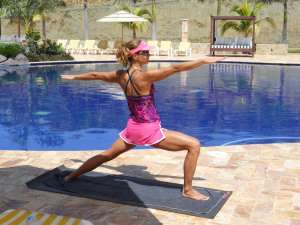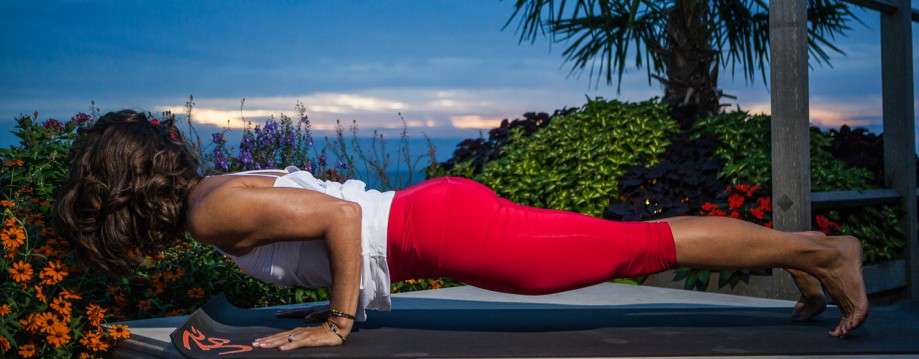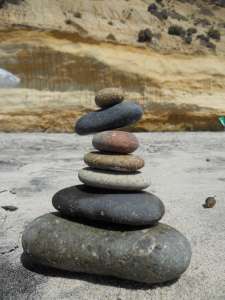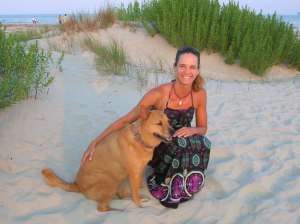
Poolside yoga in Roatan, Honduras.
What makes a good yoga practice? If you are still practicing yoga, that means you have experienced at least one sublime practice. As it is human nature to be pleasure seekers and masters at avoiding pain, it makes sense to seek that which we have enjoyed. It’s that one practice that hooked you. It’s what keeps bringing you back onto your mat time and time again. But among the good practices lie a few awful one’s too. Why is that? What is making your practices so different from one another? It even happens when it is a set sequence of postures like Ashtanga yoga. You would think that if you are doing the same poses day in and day out that you would be having a ground hog day like experience. But it’s not so.
All life has an ebb and flow. The proof is all around us. Yet we become so accustom to the changes that we don’t acknowledge their impact like we should. We are very sensitive beings. Even though its seems as if we pretty much do the same thing day in and day out, we don’t. And it’s the little things that are changing our experience on our mats. I think that’s the fun of yoga. It’s like chasing down the elusive big foot – that notion that you have seen something once, but can’t prove it. I have done some amazing things on my mat. And as much as I try to recreate all the elements that were in play the day my practice was easy, smooth and effortless, it can seem like I’m chasing something that’s a myth.
Have you ever found yourself recreating all the environmental elements that were in play that day? But yet still no luck at recreating the elusive perfect practice. You know what I mean right? You put your yoga mat in the exact same place, you practice at the exact same time of day, wear the same clothes, make it the same temperature and you try and do the poses exactly as you did that day. Hoping that when you lie down in savasana it was everything that it was the epic time before.
If we were all to describe what a perfect practice is, we would find it’s not the same between us. You might consider a perfect practice to be where you finally held crane pose with out falling on your metaphorical beak. Or it’s when you never once looked at the clock. Or there was no presence of struggle. Or you finally felt like you engaged your bandhas the whole practice. The way that I have experienced it is there was a quietness in my practice and a nice heaviness and ease in my savasana. Where it felt like I wasn’t thinking at all, I was just doing yoga for the joy of it. There is a yoga sutra that tells us out right, that if we want to have a great experience with yoga, then take this simple advice… Sutra 1.12 ” Abhyasa vairagyabhyam tannirodhah” Practice yoga with dispassion. Or more commonly said : practice without attachment to a particular outcome.
Recently, I took a vacation with my husband to the lovely island of Nevis. It was my kind of vacation, lots of relaxing by the ocean and plenty of time to roll out my mat and practice. Where ever I go, my yoga mat goes. So after we settle in, I went down by the swimming pool and rolled out my mat and proceeded to practice. I didn’t follow the ashtanga sequence. I ad-libbed some researching postures into the mix. So as I was moving along, I popped right up to a hand stand on my first try, with both legs at the same time and stuck it, then came down and carried on. I did that twice more in the practice and comfortably got into Marichyasana D, and came up out of backbends fluidly. When I finished, I was purely delighted with my practice.
Then the next day, I came out by the pool to practice. Again, I tried doing many of the same things I did the day before and it just wasn’t working. There’s a simple answer why. I’m hoping you have already figured it out. The first day that I practiced, I had no expectations. I just wanted to do yoga. But the second day, my expectation was that I wanted it to be as easy and joyful, as the day before. In a sense, I wanted to control the outcome one day and the other day I did not. I would accept the outcome. Which to me means, I was open. Open to things that I can not control and open to whatever the universe had in store for me.
There will always a percentage of the practice that you do not control. That’s the time where it is appropriate to surrender and accept. Without acceptance there is conflict. You are pitting yourself up against something, and you will usually apply force to achieve the result you are trying to control. This is usually the best teaching opportunity. What will happen is you will fail. You will be humbled, you will learn and grow by defeat. I like to say to my students when I’m teaching, that surrendering is not giving up, it’s giving in. There is a big difference between those two things. One, you walk away, the other you walk towards but peacefully, and without struggle.
Now, I’m sure being on a tropical island, under a beautiful blue sky that was filled with the intoxicating rays of the sun at the equator, and with the ocean as my backdrop, did assist my overall experience. But the real reason, that practice, was one of those knock your socks off kind, was because I wanted nothing. That doesn’t mean I was without desire. Because desire is what gets you to your mat. But once I stepped into Samastitihi, I gave into God, grace, time, whatever you want to call it . I didn’t want to stick handstand, I didn’t want to bind Marichyasana D, I just wanted to move my body as freely as it would, or could that day. It happens with running, too. On the days I head out the door for a run and I’m predicting that it has all the makings of a perfect 6 mile run, it usually turns out to be a heavy leg, slow stepping, long agonizing run. But on the days I head out the door to run and nothing else, it turns into a light, easy 8 miler. Because I had no expectation for the outcome.
There’s a great quote out of the book Born to Run. ” Think easy, light, smooth and fast. You start with easy, because if that’s all you get, that’s not so bad. Then work on light. Make it effortless. Like you don’t give a shit how high the hill is or how far you’ve got to go. When you have practiced that so long that you forget you’re practicing, you work on making it smooth. You won’t have to worry about the last one – you get those three, and you’ll be fast.” This great quote can be applied to yoga up till the fast part, as speed will not help our cause. But you can change the word fast to meditative or blissful, and this bit of advice will work just the same.
Having expectations is like predicting your outcome. There is a general societal skepticism about predictions. Right? We don’t believe someone can predict the end of the world, or when Jesus is coming back or lottery numbers. We tend to think these people that make such declarations are kooks. Yet when you step on your mat, believing that you know exactly how things are going to go, then you might as well set up shop as a fortune teller. Our past experiences do give us knowledge to how something might turn out. But to make assumptions or generalizations, will ultimately get you into trouble.
There is one other element missing for the make-up of the perfect practice, and that is belief. To believe in something means you have no doubts. That you know and trust that what you are doing is right and that it will work out. When there is still doubt, you will still be doing your practice as a study in removing your doubts. Have you ever met someone who believes in something that you think is far fetched – let’s say like big foot? What divides you, is he/she has no doubt it exists, and you do doubt that big foot exists. If your doubting the practice of yoga, then you haven’t done enough yoga yet. Tim Miller, my teacher says “Experience removes doubt.” This is true. When you have done enough yoga, you will believe in it. You will stand in that belief with conviction
I always know that the day I utter these words, “I have to do yoga today.” I have already laid the ground work for a struggle. Instead of saying “I want to do yoga today.” You need to have the desire to get there, but you need to have the grace to embrace all possible outcomes. If you step on your mat as a form of punishment or control, then you are using your body as an object instead of a vehicle. Going into your yoga practice with doubts is like driving your car with your foot on the brake and the accelerator at the same time, not trusting the vehicle and your ability to maneuver it. Take your foot off the brake, practice with abandon. Abandon your expectations, your control and your doubt and you will probably have more experiences with that elusive perfect practice.
Now, Samastitihi!

 There is great story from Indian mythology that should be an inspiring representation of what we should all be doing. In the story called the Ramayana, there is a battle of good vs. evil. One of the characters is a monkey, named Hanuman, who devotes himself to Lord Rama. All of Hanuman’s actions are of service. Hanuman is humble, and wise. Hanuman is capable of many great things, however he can not access these powers until someone reminds him of his abilities. It is through these reminders that Hanuman is able to fulfill his Dharma, his path in life. Shouldn’t we all be reminding each other of all that we are capable of? Pointing out each others strength’s and talent’s, instead of the opposite? We should be each other’s cheerleaders!
There is great story from Indian mythology that should be an inspiring representation of what we should all be doing. In the story called the Ramayana, there is a battle of good vs. evil. One of the characters is a monkey, named Hanuman, who devotes himself to Lord Rama. All of Hanuman’s actions are of service. Hanuman is humble, and wise. Hanuman is capable of many great things, however he can not access these powers until someone reminds him of his abilities. It is through these reminders that Hanuman is able to fulfill his Dharma, his path in life. Shouldn’t we all be reminding each other of all that we are capable of? Pointing out each others strength’s and talent’s, instead of the opposite? We should be each other’s cheerleaders!

